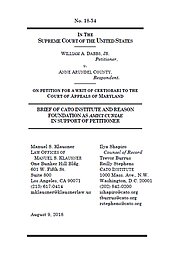Learn more about Cato’s Amicus Briefs Program.
The Constitution’s Taking Clause provides that government cannot conscript property to its own purposes without compensating the rightful owner for the value of what is taken. The most direct application of this principle is in cases of eminent domain, where the government takes title to a piece of land for some public purpose—or sometimes a not-so-public purpose. But the takings principle applies to other impositions on property rights as well, such as regulations that render a previously expensive piece of property valueless. Courts recognize that in these cases there is likewise an infringement on property rights in the name of the public good, and that such a public good should come at the expense of the public as a whole, not some particularly unlucky land owner.
The Supreme Court has repeatedly recognized the potential for these abuses and, in a series of cases beginning with 1987’s Nollan v. California Coastal Commission, it has demanded that permit requirements and development exactions bear some relationship to the actual impacts of the project. If one wishes to build an apartment building, its reasonable enough to say one should contribute to the public expense that creates when the municipality needs to build a new road to serve it. Requiring a landowner to pay for an unrelated project many miles away for the privilege of making perfectly legal improvements to their own property should be out of bounds.
But lower courts friendlier to acts of state extortion believe they have found a loophole: Nollan and its progeny dealt with specific ad hoc permitting requirements by local planning agencies. Where the legislature imposes the exaction as part of a general ordinance, however, these courts claim Nollan doesn’t apply. What principle of aggregation renders an act that is unconstitutional when applied to a specific person constitutional when applied to the public generally?
Such was the fate of William Dabbs. Anne Arundel County, Maryland required him to pay an “impact fee” to build a house on a piece of property he owned. Ostensibly, this fee was to compensate for the costs of new development on “public schools, transportation, and public safety,” but a brief glace at the ordinance demonstrates that this pretext is illusory: rather than charging, say, per unit of new development, the fee is based on the size of the house. A family living in a 3,000-square-foot house does not, on average, use more public schooling or transportation than a family in a 2,000-square-foot house (if anything, arguably the opposite), but under the ordinance it is charged more. This therefore represents an attempt to raise general revenue on the backs of disfavored individuals—precisely the evil the Takings Clause is supposed to prevent.
Dabbs has filed a petition asking the Supreme Court to hear his case and affirm that takings performed by ordinance are no less offensive to the Constitution than takings performed ad hoc. Cato, joined by the Reason Foundation, has filed a brief encouraging the Court to take the case.
New development is often opposed by a coalition of vested interests, be they governments like Anne Arundel County who demand their cut or environmental activists who live in perpetual fear of paving paradise to put up a parking lot. Thankfully, the Constitution recognizes that property rights are central to the liberty of citizens and should not be enjoyed at the sufferance of ninnying NIMBYsim. The Supreme Court should take Dabbs’ case and reaffirm that these protections cannot be circumvented by legislative gamesmanship.



